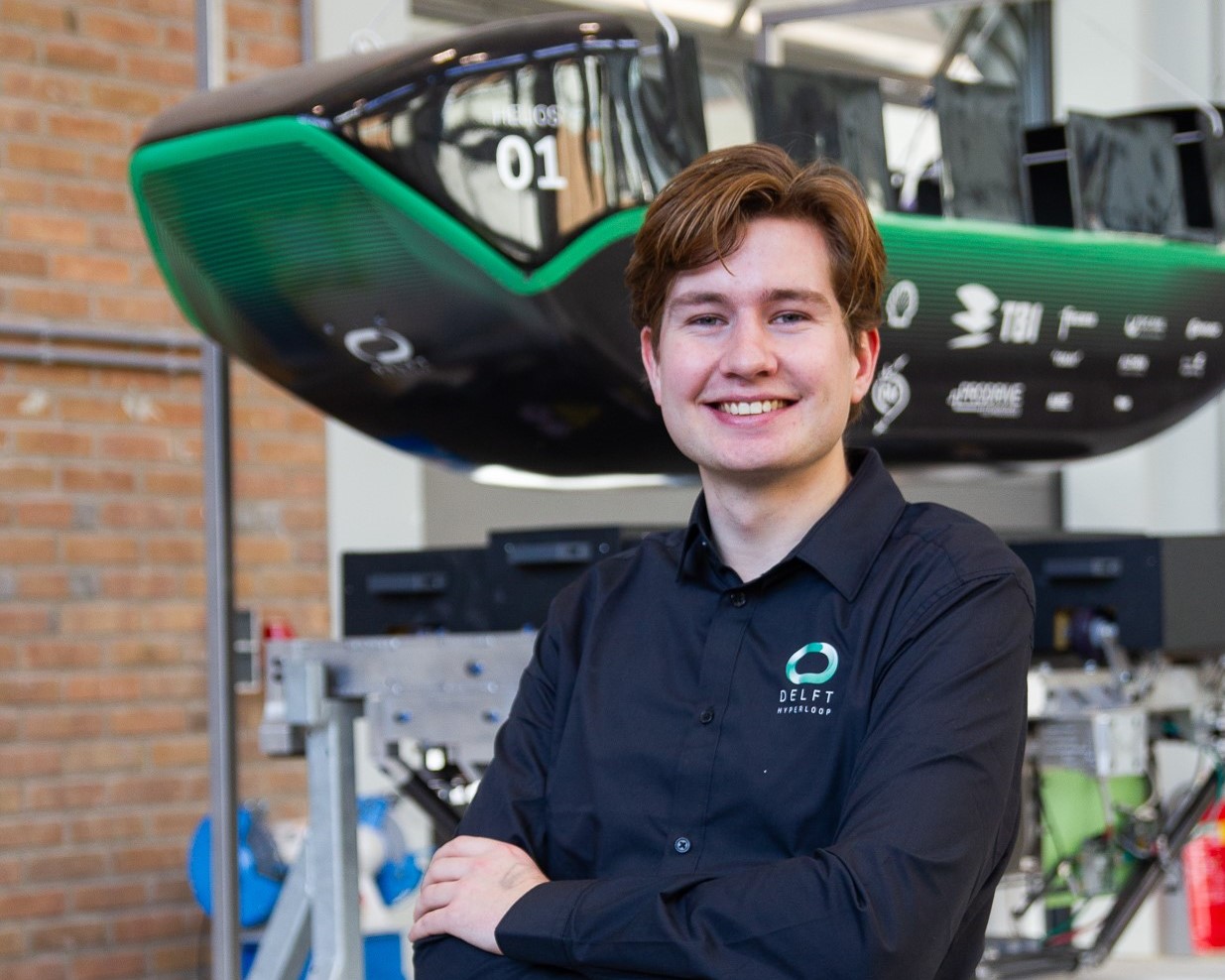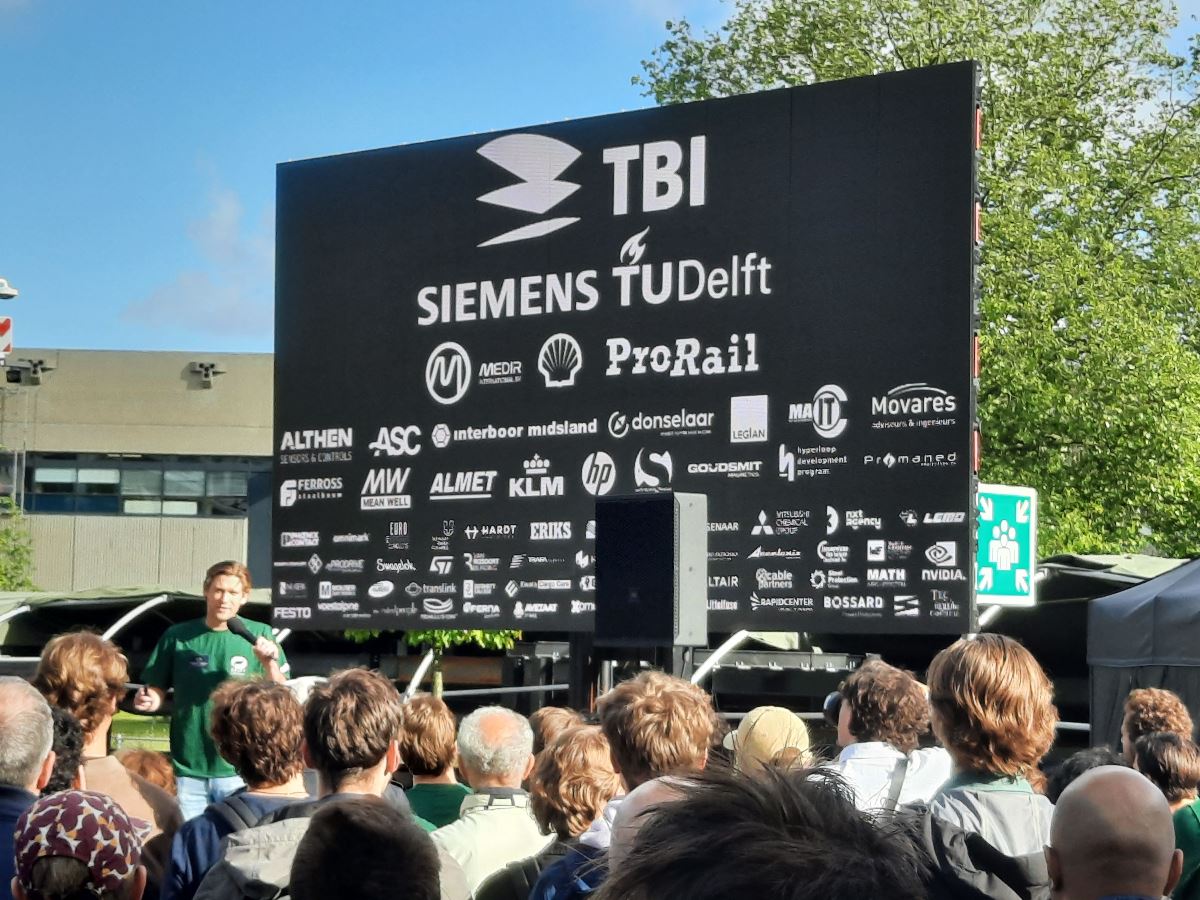The Hyperloop pod floats on magnets from Goudsmit!
We interviewed Joep Stuyfzand (Lead Propulsion) and Seb Biessen (Lead Levitation) from TU Delft's eighth Hyperloop team (Hyperloop VIII). They were working on the further development of the Hyperloop, this time called the Helios 3. In mid-July, the entire team, consisting of 39 people, will compete for the 'Full pod award'' during the European Hyperloop week in Zurich. For the latest feature, the Lane Switch, magnets from Goudsmit also play a big role again. Among other things, we asked them how they experienced the collaboration.
What is the function of magnets in the Hyperloop?
"Magnets are used for the suspension of the pod, but also for propulsion or movement. This is done with a linear motor. Magnets also provide stabilisation of the pod and, in the very latest design, also lane switch, where the pod can change lanes. Joep: ''We developed the latter and it has not been applied worldwide before. The permanent magnets in the Hyperloop are mounted vertically; they provide suspension and (passive) stability after a turn; the so-called pendulum effect. Electro magnets are mounted laterally; they provide most of the power to make a turn during the lane switch, but also provide the fine adjustments when we go straight ahead after the turn and lose contact with one of the sides."
Why did you choose Goudsmit Magnetics?
Seb: "We were alerted to Goudsmit by our predecessors, previous Delft Hyperloop teams. From them we got a list of partners they had worked with in previous years. From there, the contact arose. This is the eighth year that TU Delft has formed a Hyperloop team and competed. In the 6th year, we came to Goudsmit for sponsorship and supply of magnets."

Seb Biessen
How did you experience the advice for the use of magnets? And how did it help you guys?
Seb: ''We had a few meetings with Martijn Leskens, Team Lead Test & Application Centre at Goudsmit. He offered technical support and coordinates everything related to assembly, procurement and production. Martijn advised us how to pass on the desired specifications. We adopted the magnetic design from the previous team.
However, we were concerned that the magnets would get too hot in certain conditions and therefore demagnetise. Martijn told us how to prevent this and provided us with a graph, called a hysteresis curve, showing the conditions under which magnets can lose their power. We recorded this graph in a ''Final demonstration document'' so that the next Hyperloop team can read it after, as well as other results and findings we achieved this year."
How would you describe Goudsmit's added value in your project?
Joep: "Indispensable in defining the Hyperloop concept. This concept relies so heavily on magnets from Goudsmit. If we'd had to design around that, it would have caused a lot of trouble. Input from Goudsmit was also important for our timeline. We started in August, but Martijn immediately alerted us to the long delivery time of magnets. We thought of three to four weeks, but this turned out to be three to four months. Martijn also drew our attention to finishing the design as early as possible, so that we wouldn't run into time problems later in the project. So we also immediately set up a design, after which the magnets could be ordered. They were nicely on time, so this was never a limiting factor for us. Really great!"

Joep Stuyfzand
How did you experience the delivery and packaging of the magnets?
Joep: "The U-cores, in which the magnets are contained, first came to us, after which the magnets were glued and individually packed by you. WITHOUT magnetic appearance. They arrived well with us. I collected them myself. There was still some magnetically sensitive material in the car that I had borrowed for this purpose. That is why I first felt with a screw whether there was any radiation, but there really was none. We were also given a neat warning that the u-cores and magnets should not get too close to each other while unpacking.
How was the technical communication with your engineers?
Seb: ''Very good. Especially our concerns about demagnetisation. For that, we scheduled a meeting with Martijn. This was very enlightening and imposed a limitation on us about the design from the early stages. That was really good."
What is the goal of the Hyperloop competitions?
Joep: ''We are going to compete during the European Hyperloop week, which takes place in Zurich in mid-July, with around 40 to 60 teams from around the world for different prizes. There are competitions for a whole system, for a subsystem or for an innovation. This year, you have to choose which category you go for. We are going for the full pod award. That is why the whole prototype is going to Zurich, including our flagship lane switch. The aim, of course, is to win and get publicity of the concept, from which a commercial activity might roll out. But the latter is not the most important thing. We are a non-profit club and don't need to make money. We only do more for the innovation, the honour and to learn from it ourselves.

What are the future expectations ? Will the Hyperloop really run commercially in the future?
Joep:'' Economically, politically and socially, it is difficult. This applies not only to the Hyperloop, but also to the TGV and the Maglev. There are problems to overcome. The first problem is the technology. But even if it is ready, it is not certain that the Hyperloop will eventually make it. It depends on so many factors. Our mission is really to overcome technical barriers. And what we are also working on is socio-economic research for acceptance of such a transport system.
What is your personal motivation for joining a Hyperloop team?
Seb: "My bachelor of engineering physics turned out not to be as technical as I had thought; it was theoretical and not focused on practical applicability. For my personal development, I wanted to put my knowledge into practice. Now, after a year, I still feel more of an engineer than just after my studies. That is an important reason for me. Besides this aspect, the technology is very interesting. It is a futuristic project which ultimately contributes to a greener society."
Joep: ''I studied aerospace engineering. This too is very theoretical. I knew little about magnetism, which was a challenge in this project. The whole Hyperloop concept hinges on an ambitious team. This attracted me a lot. I was eager to throw myself into that challenge. And what also appealed to me: it is a futuristic concept. Working on a vision is always nice to do."
Hyperloop competition
TU Delft's Hyperloop team still won something every year. They also won a prize in the past during their first competition, the Hyperloop Pod Competition, sponsored by Elon Musk-founded company SpaceX. This year in particular, they expect to compete with 3 other universities, namely those of Edinburg, Valencia and Zurich, and obviously hope to win prizes again. That's bound to happen, with the Lane switch they developed. And with magnets from Goudsmit!
